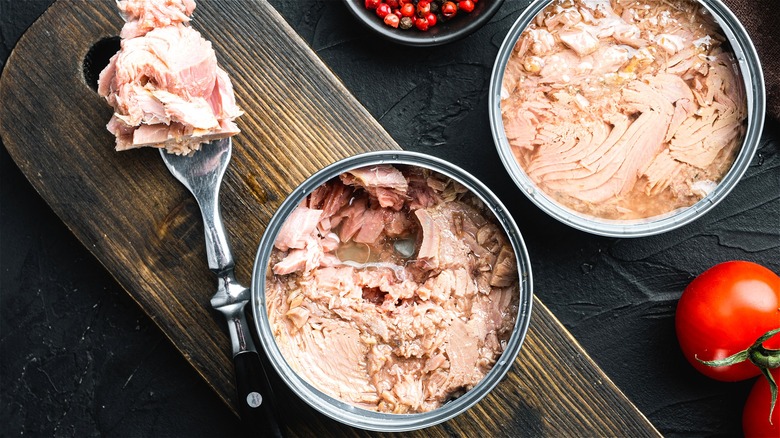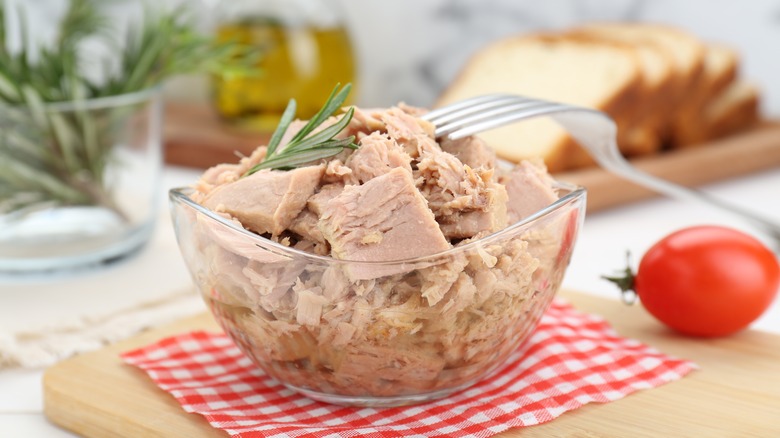Is Canned Tuna Always Made With 100% Tuna?
There are certain things you take for granted when buying food products. Take canned tuna, for example. Beyond wondering if canned tuna is raw or cooked, you might assume there's little difference between tins of this prepacked fish. However, depending on the brand, canned tuna varieties are made with more than one type of tuna fish and may include additional ingredients. Nevertheless, shelf-stable fish is a healthy food option with low price appeal and long-lasting qualities. According to Healthline, canned tuna is not only high in protein but low in fat. This convenient protein source is also rich in omega-3 fatty acids and is high in vitamin D and selenium.
Despite all canned tuna being nutritious, some key factors may alter its nutritional makeup and taste. For starters, canned tuna usually contains one of three types of tuna fish or a combination: yellowfin, skipjack, or bigeye. While these are considered light meat, a fourth, albacore, is any tinned tuna labeled "white." Chicken of the Sea claims albacore tuna has slightly more fat and calories than its lighter counterparts but reaffirms all four varieties have similar nutritional profiles. Even though these shelf-stable cans all contain 100% tuna, some minor differences might affect your chosen preference. Beyond the minor health discrepancies, depending on your taste buds, you may prefer one variety of canned tuna over another.
When to choose light versus white canned tuna
Now that you know canned tuna may contain three different species, learning the key differences between the types of canned tuna available is essential. To effectively choose the right variety to fit your needs, beyond consulting the beginner's guide to canned tuna varieties, taste-test some options before deciding which one you like best. White albacore tuna, whether you're purchasing solid or chunk cans, has a meatier texture and a mellow taste. If you're after a canned tuna derived from only one kind of fish, choose white albacore tuna. Canned white fish is typically used to dress up your favorite salad or dishes where you want the tuna to stand out.
On the other hand, the precise contents of chunk light tuna, whether skipjack, yellowfin, bigeye, or a combination, aren't noted per can. However, all three fish have a softer texture than albacore with a more concentrated fishy taste. Since chunk light tuna is made of smaller pieces, this is a great variety for traditional tuna salad or tuna noodle casserole. Even though chunk light tuna is typically cheaper than white, those who wish to know the exact fish specifications in standard cans should opt for white tuna. Next to familiarizing yourself with the most common varieties, does canned tuna contain any unexpected ingredients?
Not all canned tuna is created equal
Before you upgrade your weeknight pasta or elevate classic crostini with canned tuna, you need to know the flavor differences between cans. Some cans of tuna are packed with oil, while others are sealed with water. Nutritional differences may affect your decision in configuring when to use oil-packed tuna over water-packed. While oil-packed tuna tends to be softer and more flavorful, Healthline notes that oil-packed varieties typically contain more calories and sodium than tuna packed in water. If you're using tuna to serve as a main component of a simple salad or snack and need that extra flavor, it's fine to choose a variety made with olive oil. While tuna packed in high-grade olive oil and herbs tends to be more expensive than cans packed in vegetable oil, Healthline claims olive oil has more vitamins and minerals and is less processed. If health properties are your biggest concern, you're not completely in the clear with water-packed tuna since this variety usually comes with more cholesterol.
Whichever variety you choose, it's important to always read labels before deciding which option is best for you. Additionally, more added ingredients such as broth or salt may affect the taste of canned tuna. Read nutrition labels to learn the exact ingredients, but rest assured that tuna is always the primary ingredient in available varieties.


